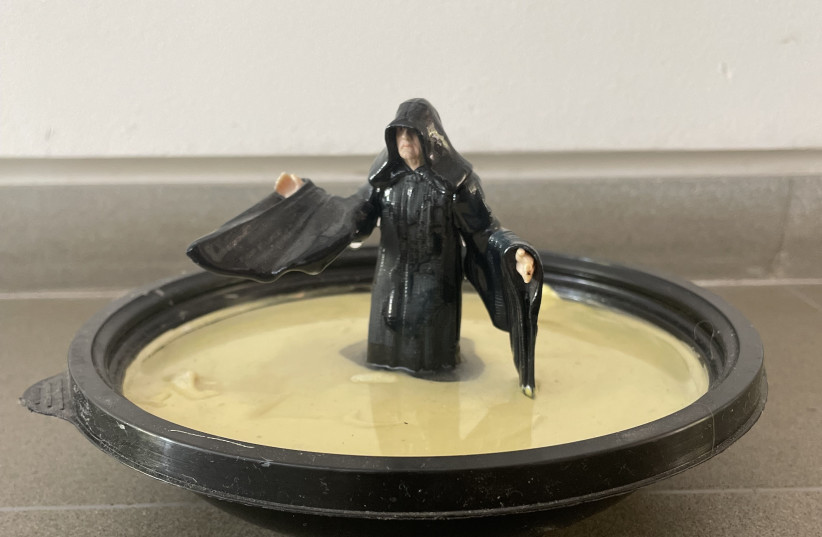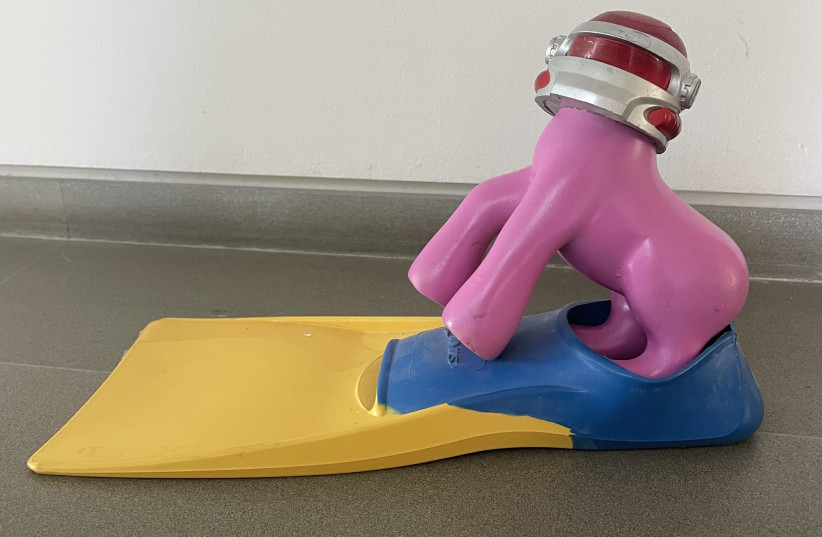What could be more engaging, more life-affirming, or more rewarding, on so many levels, than saving something from the scrap heap of society and giving it a new lease of fun and aesthetic life?
That is part of the core thinking behind Factory City, a delightful venture conceived by Itamar Shimshony that gets a Jerusalem rollout in this year’s Israel Festival, August 4 to 11.
The project’s background bumf puts the philosophy into neat evocative parlance. “One man’s junk is everyone’s treasure,” it states, adding that the pragmatic artistic exercise offers “an experiential tour for the whole family.” The “treasure” here can be discarded toys and games, in broken or in good working condition, and all sorts of personal knick-knacks that adults may have played with in their childhood.
Kids, too, have donated raw materials to Factory City. One six-year-old, for example, handed over one of his model motorbikes that he received for his fourth birthday, explaining that he was always given toy cars and motorbikes as gifts. When someone so small is moved to donate a toy, you know you’ve got to be on to a good thing.
Shimshony will be on hand at the New Gallery Artists’ Studios, in the Teddy Stadium complex, to oversee the restorative process undertaken by his band of willing compadres on the disused toys, and offer the public some insight into the initiative through guided tours. We also get to see the wider end product picture at an exhibition of videos and photographs at the Ginogly Center for Visual Arts in Katamon.

Spreading feel-good vibes at the Israel Festival
WHICHEVER WAY you look at it, Factory City is primed to spread the feel-good vibe as far and wide as possible and to get people on board – physically – the productive curative merry-go-round.
That is particularly poignant and significant when one casts one’s mind back, just around the last corner, to the dark days of lockdowns and strict curtailing of our physical freedom. The stark statistics reflect the collateral damage of that time, with suicides, domestic violence – including actual murder – issues with depression all in the ongoing fallout of the controlled pandemic passage of life.
Shimshony says he wants to address at least some of that and get us back into earnest hands-on endeavor, and wrest responsibility for our own lives back from the powers that be and their dictates. In fact, Factory City began life slap-bang in the middle of COVID-19 in Bat Yam in late 2021.
“It started at the Bat Yam Museum,” the 43-year-old artist explains. “We went to see the space [for Factory City]. You know, a space is something very personal. As an artist, you bond with the [work and/or exhibition] space.” Then officialdom intervenes and summarily shuffles the emotional pack. “Someone comes in and says ‘OK, this goes here and that goes there. Let’s go!’” says Shimshony, his mouth agape.
That sanitized intervention, he believes, is redressed as soon as you get down to the individual, heartfelt brass tacks. “Then you move on, and an 89-year-old widower, who looks wonderful, and is a dab hand at welding and great with his hands, comes along and takes up his station. He became our chief.”
Gradually, the Bat Yam-based Factory City enterprise began to take shape. The aforementioned golden age gent was soon complemented by willing colleagues of all vintages – high school and college students, and other adults – who joined in to make up the toys, games, clothes repair, and makeover team. Barbie doll parts were incorporated into funky-looking key rings, and an outgrown pair of a kid’s sandals had some weird tubing attached to them and turned into a sort of fetching ready-made statuette.
After a while, Israel Festival artistic directors Michal Vaknin and Itay Mautner got wind of the proletarian goings-on south of Tel Aviv and went over for a professional look. “They were very enthusiastic about it,” says Shimshony, with a touch or two of understatement.
Nevertheless, it is all fine and dandy coming up with a great idea, following a 1,000-watt flash of inspiration, but putting it into practice involves all sorts of logistics that can deflate even the most passionate of dreamers. But that visit by the festival honchos set the seal, not only on the project but helped to remove the veil of hesitancy from Shimshony’s career path. “I realized that this is my baby in life,” he laughs.
HE HAD paid his educational and artistic dues. After graduating from the Bezalel Academy of Arts and Design, among other professional gigs, he headed a department at the School of the Arts in Tel Aviv. But Factory City was a different thing entirely.
“I was a bit overwhelmed by the whole thing [in the best sense],” he notes. “It was so fantastic. I wondered what I had done to deserve all this goodness.”
He may have felt he had hit the jackpot, but he wasn’t exactly sitting around just rubbing his hands with glee. For him, Factory City is a winner on so many scores. It got off to a pretty impressive start, too. “We brought 1,500 people for guided tours in Bat Yam. That’s not too bad,” he chuckles.
Rather than bask in the glory of a job well done, Shimshony felt his heartstrings tugging him over this way. “My heart told me this needs to happen in Jerusalem.”
The tough, Tel Aviv-based entrepreneur got going and dropped by the Jerusalem Municipality for a chat with Visual Arts Department head Hila Smolansky. He found a sympathetic ear and a supporting hand. “She said I should work with two locations – Ginogly and the New Gallery. She said Ginogly should be the home base.” Shimshony had no problems with that approach.
The idea was not just to work toward getting an exhibition facility up and running but to show the public what Factory City produces. Shimshony needed to make sure the personnel he was going to take on was up to the creative work job, and that the chemistry would be there. “I needed to know they were able to use the right tools, like a Stanley knife, and we had to make sure they would bond among themselves. That is a very important part of the process.”
Having the municipality on board was, of course, a boon, and it has been joined by the Jerusalem Foundation, with additional generous assistance provided by New Yorker couple Melinda and Ealan Wingate.
The project team began to take shape, with Shimshony providing the requisite training. And if he’d needed any encouragement, he says he got that from the outset. “I saw the look in their eyes and felt their spirit.”
Willing workers joined in from all societal quarters. “I have 25 senior citizens and a very enthusiastic bunch of high school students. It has also always been clear to me that the Arab population of Jerusalem had to be involved in this too. I have people of all ages from Beit Safafa on the team.”
Despite his residence at the western end of Route 1, Shimshony has a soft spot for the capital. “I have family here, and friends, and I spent four years at Bezalel. Jerusalem is special for me.”

How to run a complex program
RUNNING SUCH a complex program is a challenge from multiple perspectives – gathering the base resources, and making sure you have the right team with the requisite work and interpersonal skills, to mention but a few. The latter objective is facilitated by the physical industrially-oriented structure Shimshony devised for the founding Bat Yam start-up and for the production facility at the New Gallery.
“The factory is divided according to departments,” he explains. That is partly a derivative of the raw materials gathered from the locals which, naturally, require different handling and production methods. “There is the welding department, a sewing department, carpentry, a production line. All sorts.”
Shimshony says the guided tour participants will get a good idea of the serious intent of the enterprise as soon as they get a glimpse of the tailored New Gallery interior.
“All the workers wear caps and work coats. They have lunch together. There is a morning shift and an afternoon shift. And there is a showroom, so people can see what we are doing and what we end up with.”
This is clearly no fly-by-night exercise. “There will also be a mobile store where people can purchase what we make.”
Somehow, I wasn’t surprised when I learned of the philanthropic designation of the proceeds. “The money we make will go to Climate Forest, which plants trees around Jerusalem,” he says. The nonprofit promotes sustainable and ecological tree planting in urban environments around the country. Nothing like air quality and shade to help improve life for city dwellers.
Factory City has a definitive ecological element to it, as Shimshony’s valiant cohorts do their bit to keep the consumer society-driven, easy-come/easy-go mindset in check by creatively recycling basically impractical items that would otherwise just be added to the global garbage heap. The educational, environmental, and societal benefits of the initiative are patently there every way you turn.
THERE IS a clear performance disciplinary aspect to the Factory City project which, Shimshony insists, offers much more than just an intriguing and, hopefully, smile-inducing experience for workers and members of the general public alike. “This is going to happen as part of the Israel Festival,” he says, “and that is wonderful. But I, and this, are not going to go away. This is going to carry on.”
Shimshony is looking forward to the Jerusalem slot, and to subsequently taking the show on the road. “The idea of Factory City is to establish some kind of ensemble. There are all sorts of events, like Fresh Paint (annual art fair), where we can execute sculpture as a sort of performance in the public domain, at festivals and such. I don’t want to get into the community circuit and cultural activities sector. I want to operate in the arts domain.”
There is even more to the initiative which, Shimshony feels, can have far-reaching impact across society, especially for the leaders of tomorrow. “This is also about conveying the sense of a factory to kids, too. How many people in general, let alone children, have ever been to a factory? Perhaps they have taken a guided tour of the Elite chocolate factory, but that’s probably about it.
“People who come to see what we do get some idea of the rhythm of the work, and they will see the production process happening before their very eyes,” he says.
In an increasingly sanitized, remote, virtual, global village way of life, that is quite a revolutionary wholesome, back-to-roots notion. ❖
For tickets and more information, visit www.israel-festival.org.
